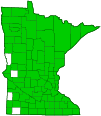Common garter snake
(Thamnophis sirtalis)
Conservation • Description • Habitat • Ecology • Distribution • Taxonomy
Conservation Status |
|||
| IUCN Red List | LC - Least Concern |
||
| NatureServe | N5 - Secure S5 - Secure |
||
| Minnesota | not listed |
||
Description
Common garter snake is a medium-sized, typical snake. It is the most common snake in Minnesota.
Adults can be from 14″ to 48″ long at maturity, though they are usually no more than 16″ in length. Females are slightly longer and significantly heavier than males.
The background color is variable and may be light brown to black or olive green. There are three pale stripes that run the length of the body. The central stripe is light yellow. The lateral stripes are cream-colored to pale yellowish, and are on the second and third scale rows counting up from the belly (ventral) scales. There are two rows of alternating black spots on each side between the central and lateral stripes. The spots may be prominent and invade the stripes, or may be obscured on dark colored individuals. The upper (dorsal) and lateral scales have a narrow raised ridge (keel) along the centerline. At mid-body there are 19 to 21 rows of scales. On the eastern garter snake red skin may be visible between the scales when it stretched over recently consumed prey, but there are no red scales. On the red-sided garter snake there are bold red bars or spots between the central and lateral stripes.
The belly is white and may be tinted yellowish or bluish. There is usually a row of small black spots at the ends of the ventral scales. These spots are partially hidden by overlapping ventral scales. The anal plate is not divided. Underneath the tail there are two rows of scales (subcaudal scales).
The head and neck are uniformly dark usually with a pair of yellow spots. The scales above the mouth (labial scales) are the same color as the lateral stripe. Usually only one or two labial scales have a bold black border.
The subspecies red-sided garter snake (Thamnophis sirtalis parietalis) has bold red bars or spots on the side between the dorsal and lateral scales.
Size
Total length: 14″ to 48″
Similar Species
Plains garter snake (Thamnophis radix) lateral pale stripes are on the third and fourth scale rows counting up from the ventral scales. Usually all labial scales have a bold black border.
Lined snake (Tropidoclonion lineatum) is much shorter, only 8″ to 12″ long at maturity. The 3 stripes are off-white. There are 2 rows of dark, half-moon marks on the belly. In Minnesota it has been found only in Blue Mounds State Park.
Habitat
Wide variety of habitats. Moist, grassy places. Forests, forest edges, prairies, meadows, and other areas near water.
Ecology
Behavior
Lifespan
5 to 10 years
Life Cycle
Overwintering Common Garter Snakes emerge from their overwintering sites in March. Females reach sexual maturity in 2 or 3 years. Breeding takes place in April or May. Gestation takes 83 to 102 days. In July to September the female gives birth to a litter of 4¾″ to 9½″ long, live young. The litter size is usually 10 to 20 but may be as few as 5 or as many as 60. The young are on their own from the day of their birth.
In late October they gather in large numbers, sometimes with other species of snakes, in rodent burrows, abandoned ant mounds, or under sidewalks, to overwinter. As the temperature drops they enter a state of sluggishness, inactivity, and torpor (brumation). It is similar to hibernation in mammals, but they stir occasionally to drink water.
Food
Earthworms, amphibians, leeches, slugs, snails, insects, crayfish, small fish, bird eggs, mice, other snakes, and carrion.
Toxicity
Common garter snakes are venomous but their venom is not strong enough to cause serious harm to humans. Allergic reactions to a bite from a Common Garter Snake are rare. Reaction to a bite is normally little more than swelling and irritation around the puncture wound. However, like a bite from any animal, bacteria from the mouth of the snake can cause an infection.
Distribution |
||
|
Sources Biodiversity occurrence data published by: Minnesota Biodiversity Atlas (accessed through the Minnesota Biodiversity Atlas Portal, bellatlas.umn.edu, 10/26/2025). |
|
| 10/26/2025 | ||
Occurrence |
||
|
||
Taxonomy
Class
Reptilia (Reptiles)
Superorder
Lepidosauria
Order
Squamata (Snakes and Lizards)
Suborder
Serpentes (Snakes)
Infraorder
Alethinophidia
Superfamily
Colubroidea
Family
Colubridae (Harmless Egg-laying Snakes)
Subfamily
Natricinae
Genus
Thamnophis (garter snakes)
Subordinate Taxa
bluestripe garter snake (Thamnophis sirtalis similis)
California Red-sided garter snake (Thamnophis sirtalis infernalis)
Chicago garter snake (Thamnophis sirtalis semifasciatus)
Common Garter Snake (Thamnophis sirtalis lowei)
eastern garter snake (Thamnophis sirtalis sirtalis) ![]()
maritime garter snake (Thamnophis sirtalis pallidulus)
New Mexico garter snake (Thamnophis sirtalis dorsalis)
Puget Sound garter snake (Thamnophis sirtalis pickeringii)
red-sided garter snake (Thamnophis sirtalis parietalis) ![]()
red-spotted garter snake (Thamnophis sirtalis concinnus)
San Francisco garter snake (Thamnophis sirtalis tetrataenia)
Texas garter snake (Thamnophis sirtalis annectens)
valley garter snake (Thamnophis sirtalis fitchi)
Synonyms
Coluber Sirtalis
Coluber ordinatus
Tropidonotus concinnus
Eutainia sirtalis
Eutainia dorsalis
Eutainia infernalis
Eutainia pickeringii
Eutainia concinna
Tropidonotus bi-punctatus
Eutaenia sirtalis obscura
Tropidonotus sirtalis
Eutanaeia sirtalis (misspelling)
Eutaenia sirtalis
Tropidonotus ordinatus var. sirtalis
Eutaenia sirtalis ordinata
Eutaenia sirtalis obscura
Tammophis sirtalis (misspelling)
Common Names
Common Garter Snake
common gartersnake
Glossary
Anal plate
In snakes: the large scale in front of and covering the anus. In turtles: one of the posterior plates of the lower shell (plastron). In Lepidoptera: the often hardened shield on the dorsal surface of the last (10th) segment of the abdomen.
Brumation
Winter dormancy in reptiles. A cold-induced period of sluggishness, inactivity, and torpor in reptiles, akin to hibernation in mammals, but they stir occasionally to drink water.
Ventral scales
On snakes, the row of enlarged, elongated scales extending on the belly from the neck to the anal plate.
Visitor Photos
Share your photo of this reptile.
This button not working for you?
Simply email us at info@MinnesotaSeasons.com.
Attach one or more photos and, if you like, a caption.
Dan W. Andree |
||
Seen it on the edge of a gravel road near the Dalby WMA today. A little darker version of one. |
||
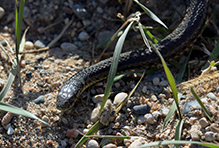 |
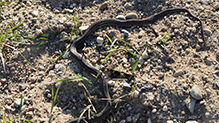 |
|
Delainie Davis |
||
found and caught two garter snakes on a trail by my house. The larger one seemed to have just finished a shed, since it had some stuck shed on its face and a little on its back |
||
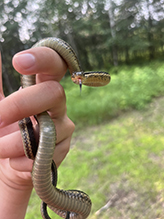 |
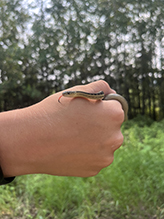 |
|
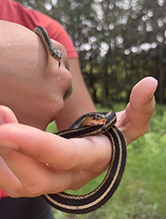 |
||
I have found 2 Common Garter Snakes In Big Lake, MN (Sherburne County). A young Garter (my sister named Gregory) and a decent sized adult (I named Meanie). Found while herping in a nearby forest basking on the concrete trail. Released shortly after observing in a bucket for a bit! |
||
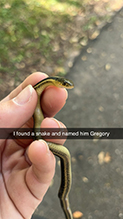 |
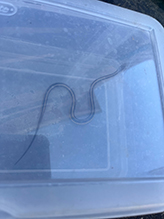 |
|
Lane Keller |
||
This snake was hiding in the rocks next to the river where it was basking in the sun to start of the day off with hunting leopard frogs that were everywhere in the state park. |
||
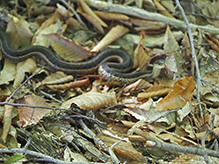 |
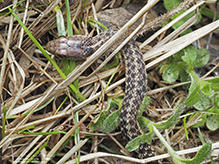 |
|
Alfredo Colon |
||
 |
 |
|
Theodore Loftsgard |
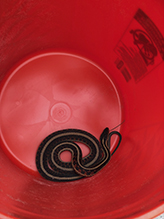 |
Red sided garter snake near my house in a trench under sod pieces. Relocated to Quarry Hill. |
Margot Avey |
||
This guy was big! |
||
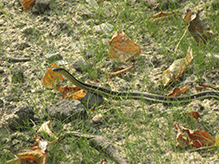 |
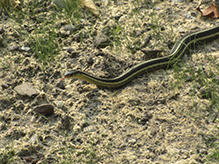 |
|
Kirk Nelson |
Red-sided Garter Snake |
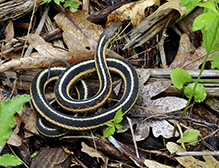 |
Luciearl |
||
This garter sat very still so "I couldn't see it". Actually saw it very well and was able to take several photos. About 2 ft. long. |
||
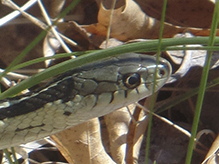 |
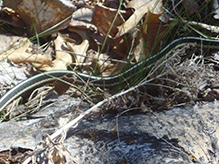 |
|
Jimmy Hultgren |
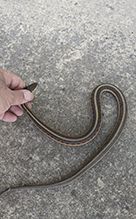 |
Chris H. |
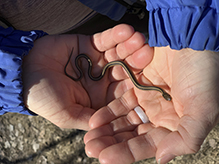 |
After a record cold week, the sunshine finally warmed things up enough for some springtime sightings like pasque flowers and this little garter. |
Robert Briggs |
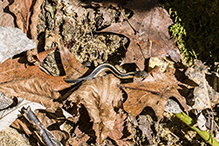 |
I'm fairly certain this is a common rather than plains. Didn't get close enough with this picture - I had a wide angle lens on at the time. |
Ida Marie |
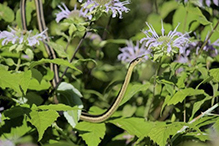 |
I was in the bee balm photographing that red spotted purple butterfly yesterday and 4 and 1/2 feet off the ground this snake appears and scared the living day lights out of me....he had to be at least 3 feet long. |
MinnesotaSeasons.com Photos
eastern garter snake (Thamnophis sirtalis sirtalis) |
||
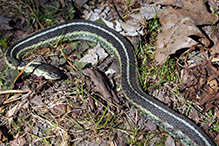 |
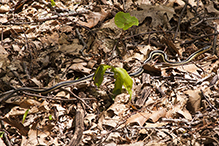 |
|
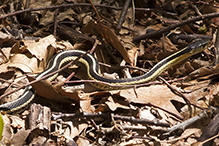 |
 |
|
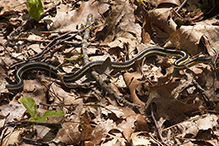 |
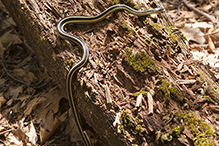 |
|
red-sided garter snake (Thamnophis sirtalis parietalis) |
||
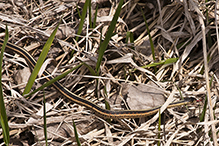 |
||

Slideshows
Common Garter Snake (Thamnophis sirtalis)
Andree Reno Sanborn
Thamnophis sirtalis (Eastern Garter Snake)
Allen Chartier

Visitor Videos
Share your video of this reptile.
This button not working for you?
Simply email us at info@MinnesotaSeasons.com.
Attach a video, a YouTube link, or a cloud storage link.
Other Videos
Wild Thamnophis sirtalis sirtalis eating Bufo americanus!! 1 June 2013
FlapsMemoir
Garter Snake Foreplay (Colubridae: Thamnophis sirtalis sirtalis)
Carl Barrentine

Visitor Sightings
Report a sighting of this reptile.
This button not working for you?
Simply email us at info@MinnesotaSeasons.com.
Be sure to include a location.
Photo by Dan W. Andree
10/25/2025
Delainie Davis
7/12/2025
Delainie Davis
9/29/2024

Location: Big Lake, MN (Sherburne County)
I have found 2 Common Garter Snakes In Big Lake, MN (sherburne county). A young Garter (my sister named Gregory) and a decent sized adult (I named Meanie). Found while herping in a nearby forest basking on the concrete trail. Released shortly after observing in a bucket for a bit!
Lane Keller
9/12/2022
Theodore Loftsgard
7/1/2021
Marvin Gerald
6/15/2021
Location: Kandi Chippewa Line SE, Raymon, MN 56282
Sighting around 09:30AM with a live frog in its mouth among some cut tree branches on the ground. I startled it and it escaped into some nearby tall grass.
Luciearl
5/8/2020
Chris H.
4/19/2020
Robert Briggs
10/22/2016

